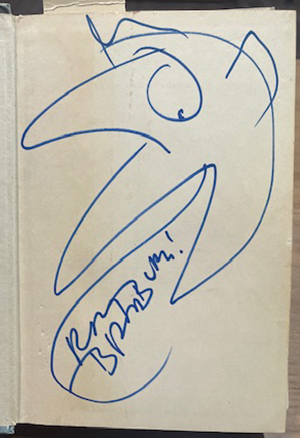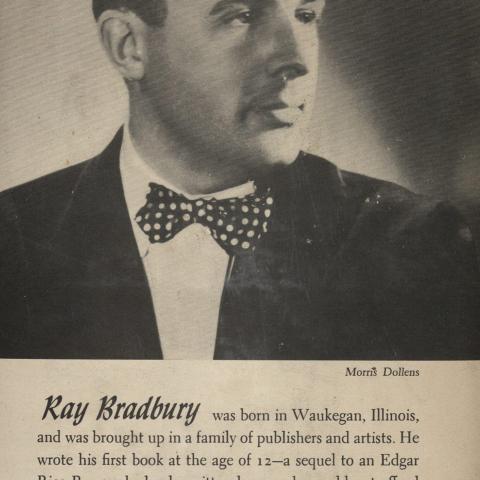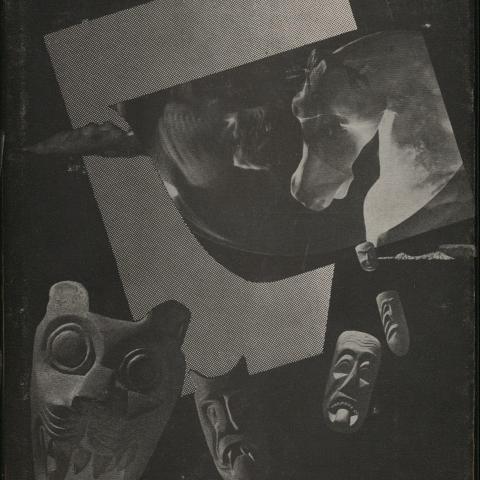Ray Bradbury
September 23, 2025
 Ray Bradbury was an American author and screenwriter of multiple genres, best known for fantasy and science fiction. Born in 1920 in Waukegan, Illinois, he moved to California in 1934 and graduated from Los Angeles High School in 1938. Forsaking college due to cost, Bradbury opted to learn and write in L.A.’s public libraries. Early on, he joined the Los Angeles Science Fantasy Society, which influenced his writing and expanded his local writing circle. He started off by publishing short stories in sci-fi fanzines, many of which reappeared in his later works. Special Collections & Archives houses numerous Bradbury works, including first editions and some signed by the author (with drawings), all available for access in the Special Collections & Archives Reading Room.
Ray Bradbury was an American author and screenwriter of multiple genres, best known for fantasy and science fiction. Born in 1920 in Waukegan, Illinois, he moved to California in 1934 and graduated from Los Angeles High School in 1938. Forsaking college due to cost, Bradbury opted to learn and write in L.A.’s public libraries. Early on, he joined the Los Angeles Science Fantasy Society, which influenced his writing and expanded his local writing circle. He started off by publishing short stories in sci-fi fanzines, many of which reappeared in his later works. Special Collections & Archives houses numerous Bradbury works, including first editions and some signed by the author (with drawings), all available for access in the Special Collections & Archives Reading Room.
The Martian Chronicles is a “fix-up” novel, a group of previously published short stories weaved into a new narrative. In this 1950 novel, humans attempt to colonize Mars and “Martians” to escape an endangered Earth doomed by nuclear war. Fahrenheit 451 is set in a future dystopia where books are forbidden and burned upon seizure. Although often described as a book on censorship, Bradbury was more pointedly criticizing how popular entertainment and technological advancements at the time were dulling minds instead of cultivating knowledge. The story in its first iteration is the novella The Fireman in the February 1951 issue of Galaxy Science Fiction. He lengthened the story, typed it in UCLA’s Powell Library, and renamed it “Fahrenheit 451” after learning that paper burns at that temperature from a local L.A. fire chief. After being published in 1953, it was reprinted in 1954 as a three-issue serial in Playboy, a new provocative magazine that had debuted in December 1953. The Illustrated Man, a short story collection from 1951, refers to the character the Illustrated Man, who previously worked in a carnival and is heavily tattooed, all inked by a mysterious female time-traveler. Each of his tattoos embody a tale and become animated to tell their story.
Beyond sci-fi and fantasy, Bradbury explored themes of death, autumn, and the carnivalesque, with children often as main characters. Dark Carnival is Bradbury’s first published short story compilation from 1947. One story, “The Lake,” is a poignant ghost story about the loss of a childhood friend and the narrator later in life revisiting the site of her drowning. The October Country from 1955 runs in a similar vein to the previous book, as it includes many stories, some updated, that were originally seen in Dark Carnival. In “The Emissary,” a young boy confined to his room depends on his dog to randomly bring him things from the outside world - inanimate, animate, or something in between. The Mummies of Guanajuato, a pictorial work published in 1978, captures two reactions after seeing in real life naturally mummified humans in Guanajuato, Mexico. Archie Lieberman pairs his somber 1970s photography of the actual human remains and scenes from the town alongside Bradbury’s nightmarish 1947 short story, “The Next in Line,” inspired by Bradbury’s visit to the same place.
Bradbury had roots at CSUN, evident in certain special publications and archival materials. He knew Norman Tanis, dean of CSUN University Library (1969-1990) and editor of Santa Susana Press, a fine press on campus that published limited editions of various works. The press printed and/or published several Bradbury works, such as About Norman Corwin, a portfolio dedicated to the renowned radio broadcaster. A January 18, 1982 Daily Sundial article highlighted their collaboration with an image of Bradbury and Tanis demonstrating the hand press in the CSUN University Library lobby. In The Last Good Kiss: A Poem, CSUN professor emeritus and Swiss-American abstract expressionist Hans Burkhardt illustrated Bradbury’s poem with red and black linoleum block prints on loose leaf, housed in a portfolio. Pall Boehne designed and reprinted Bradbury poem’s, “The Bike Repairmen,” in 1978 for CSUN Library’s Ray Bradbury celebration and CSUN’s twentieth anniversary. The poem is in the Fine Press Prints, Broadsides, and Ephemera Collection. For the same occasion, Irving Block, CSUN art professor emeritus, donated a bronze medallion, found in the Irving Block Collection. At another local fine press, the Gold Stein Press in Santa Ana, Bradbury published in 1985 the miniature limited-edition artist book, Long After Ecclesiastes: New Biblical Texts, and Special Collections has no. 17 signed.
You can find many other Ray Bradbury titles in Special Collections, as well as hundreds of other sci-fi and fantasy publications, especially in the Milt Stevens Science Fiction Collection.
Image Gallery
Post tagged as: publications, special collections, los angeles, united states
Read more Peek in the Stacks blog entries










